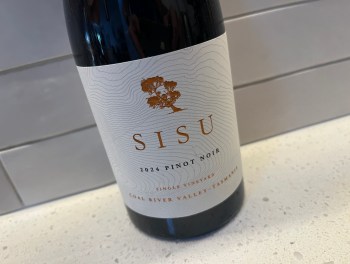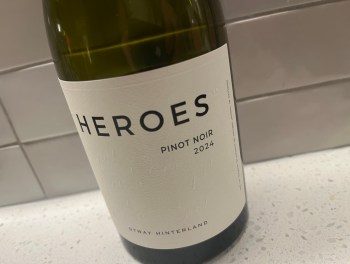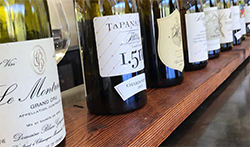On the road: Mornington Peninsula
 |
| Classic Mornington Peninsula weather. Beautiful vista regardless (Taken at Eldridge) |
I’m back in travel mode at the moment, spending this week in (not so) sunny northern Victoria for a spell of university on-campus study (where I’m going go be spending much of the week doing fining trials. Excitement) with Brisbane wine writer Julian Coldrey of Full Pour (who is also completing his Masters of Wine Technology and Viticulture like me).
Before arriving here in Dookie (where the University of Melbourne’s rural campus, winery and vineyard are located) though I actually spent the weekend on Victoria’s Mornington Peninsula (accompanied by Mr Coldrey. He’s not the biggest fan of my driving and I don’t appreciate a lot of the music on his iPod. We’re even..), a part of the world that I rather like (not just for the the wines either) yet haven’t visited in a few years. It’s a region that appears to have changed quite markedly since my last visit (which was about 4 years ago) too.
Perhaps one of the most obvious of these changes is simply the quality of the winery cellar doors, many of which seem much slicker this time around. Indeed it appears everybody now has a (typically high-end leaning) restaurant, many cellar doors are now charging tasting fees and the cellar door structures themselves are more likely to be (again high-end leaning) architecturally designed outposts of modernity. I’m not begrudging such a change, more interested to note the change (and in most cases it’s for the better).
Besides just the polish of this modern approach to selling wine, it is the offerings that have changed to, with a movement towards ever more detailed super cuvées being released in ever decreasing amounts. The main driver of this is a move by producers to now delineate wines not just by their vineyard or block alone but going one step further to make them clonal specific in an (interesting) for diversity and terroir driven wines. For mine this seems a logical move, although it does raise the question about whether it might damage ‘estate’ wines and also push up prices. Time will tell.
As for the wines themselves, it is rather obvious that there has been some challenging vintages of late – for varying reasons – as well as some very good ones. 2012, for example, is set to be a very good, even season across most varieties, albeit with some big losses in yields (up to 50% in some vineyards). Couple the losses of this vintage with those of the similarly low yielding 2011 crop (which was described as ‘a horror’ by someone over the weekend) and you’ve got seriously little stocks of wine to play with. Speaking of 2011 you can see some of the challenges of this horror year in the wines too, which almost uniformly show elevated levels of acidity and a lack of fruit sweetness. It was a hard year (though not necessarily a write-off. There will be joyous wines still).
Conversely, 2010 is the vintage that dreams are made of. Unbridled enthusiasm emanates from many mouths about the quality of the season and you can see absolutely see it in the wines, particularly the Pinot Noirs. Mark 2010 Mornington Pinots down as ‘must buys’ for your favourite makers. Heck, get down to the Peninsula yourself to check them out. They live up to the hype…
In contrast, many of the 2009 vintage Pinots are looking less pretty and more masculine, tasting harder, less fresh and even confected with a general lack of elegance and delicacy. Of course that’s not a uniform response and many makers 09s are quite smart, yet it’s not hard to see the challenges writ large in many wines. It’s probably of little surprise that the 09 Pinots look so variable actually given that – and I was told this more than once – Pinot Noir was one of the hardest hit grapes in the record 2009 heatwave. Then again some of the whites look rather smart, if in a more luscious mould, and again there is serious joy to be had. Approach on a case by case basis for sure.
Finally then, the wine highlights:
Main Ridge 1/2 Acre Pinot Noir 2010: Had a long chat with Nat White about screwcaps, wine trends, the Peninsula and styles over the weekend. It was great. Suffice to say that if you are ever on the Peninsula and keen to gain an insight from one of the pioneers, then make sure you stop in at Main Ridge. This wine too is a masterful one – immediately rich and freely full of flavour it carefully balances firmness with acidity with enough fruit. What makes this so good though is just how assured it is. It tastes of consistency, of a site in balance, of a style and a maker very comfortable with where they sit. It is the sort of Pinot that you could comfortably slot in with a group of 1er cru Chambolle Musignys and know it wouldn’t sit out of place. A truly fantastic wine. Wish I could afford to buy heaps. 18.7/95
Eldridge North Patch Chardonnay 2010: This is, in the scheme of things, almost an entry level wine for David Lloyd, priced $10 cheaper than his Estate Chardonnay yet hardly inferior in quality. What I most like about this wine is it’s limpid freshness, a purity of expression that sees it look all the more vibrant and deftly made than many others on the Peninsula (and quite representative of the clear purity that David’s wines show). Classy Chardonnay indeed. 18/93
Ten Minutes by Tractor Wallis Chardonnay 2009: We were similarly lucky to catch-up yesterday with Chris Hamilton, General Manager of Ten Minutes by Tractor, a committed Peninsula fan who effectively runs the Ten Minutes by Tractor business for owner Martin Spedding. Besides the lunch itself (which was seriously exceptional. Two hat quality, one hat prices) it was this wine that most caught my eye for I think it shows a style of Peninsula Chardonnay that I rather like. Sourced from a vineyard closer to the ocean than the other ‘estate’ vineyards, Wallace is technically the earliest ripening of these vineyards yet this wine tends to look the most mineral (or it did in 2009 at least) of the Chardonnays, helped out apparently by the fresh afternoon sea breezes. What I like most about this wine is that straddles the richer style of Mornington Chardonnay yet with a minerality to it that is undeniable. It’s hardly Chablis in style but it is more than a little Corton Charlemagne in it’s balance of intensity and acidity, both of which are in good proportions this year. A seriously fine modern Chardonnay it’s hard not to appreciate this. 18.4/94
Quealy Amphora Fruilano 2011: As the name suggests this was made in traditional clay amphora by ex T’Gallant maestro Kathleen Quealy. Like many of the northern Italian Fruilano (which are made in amphora by famous proponents like Gravner) this has a beautifully floral, lively sort of profile, an essay in vibrancy of fruit and the expression that this variety can show when treated carefully. On the palate it shows some of the raised acidity of the vintage yet the wine has enough fruit sweetness to carry it off. Simply put all of Kathleen’s wines taste ‘alive’ and you can just taste the minimal handling, the lack of intervention and genuine transparency as a result. This is undoubtedly one intriguing wine for $25. 17.7/92
Help keep this site paywall free – donate here





5 Comments
Are you saying you didn't like the mini 80s megamix I carefully crafted for you on the way to Dookie?! 🙂
That Main Ridge wine was seriously good.
Did you try 10 Minutes By Tractor's rose and pinot gris? Despite being 2 of my least favourite varietals, the barrel ferment took them to another levelfor me .
I just wish they weren't so expensive 🙁
Absolutely agree on the 10X Pinot Gris in particular. A standout for Gris quality. Didn't quite love the 11 Rose as much.
Sounds like a good trip. Including the 80s megamix 🙂
Looking forward to the 2010 versions of the Eldridge Pinot and Chardonnay personally. David Lloyd's wines are some of my favourite from the MP
davemarine
I grew up on the Peninsula, and you are right about the change. It has been slowly gathering momentum but in the past few years it has really picked up speed. I think there has been giant leaps in the quality of the wine too although the cold and wet vintages make things very difficult there